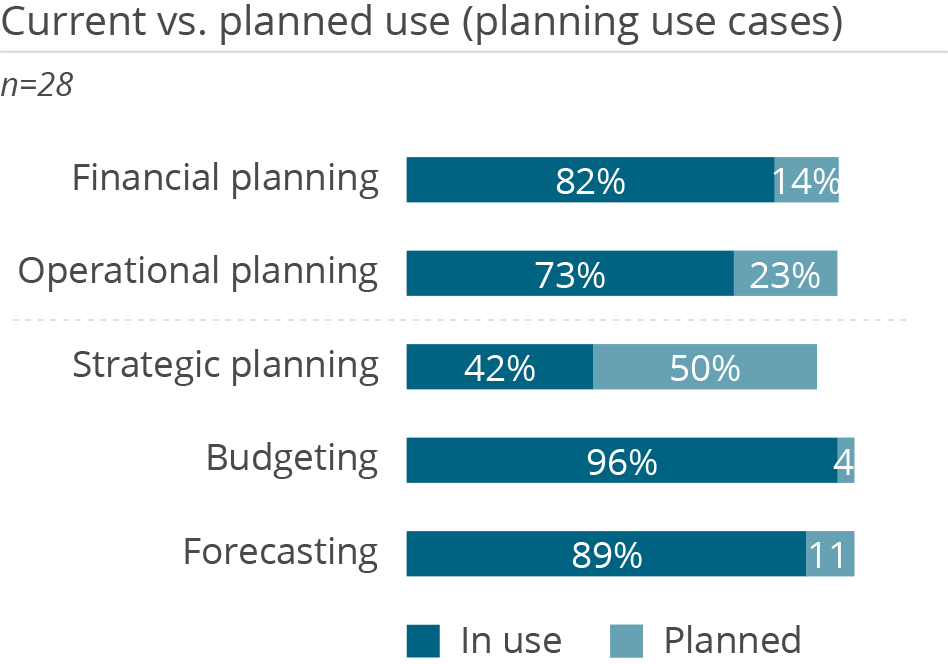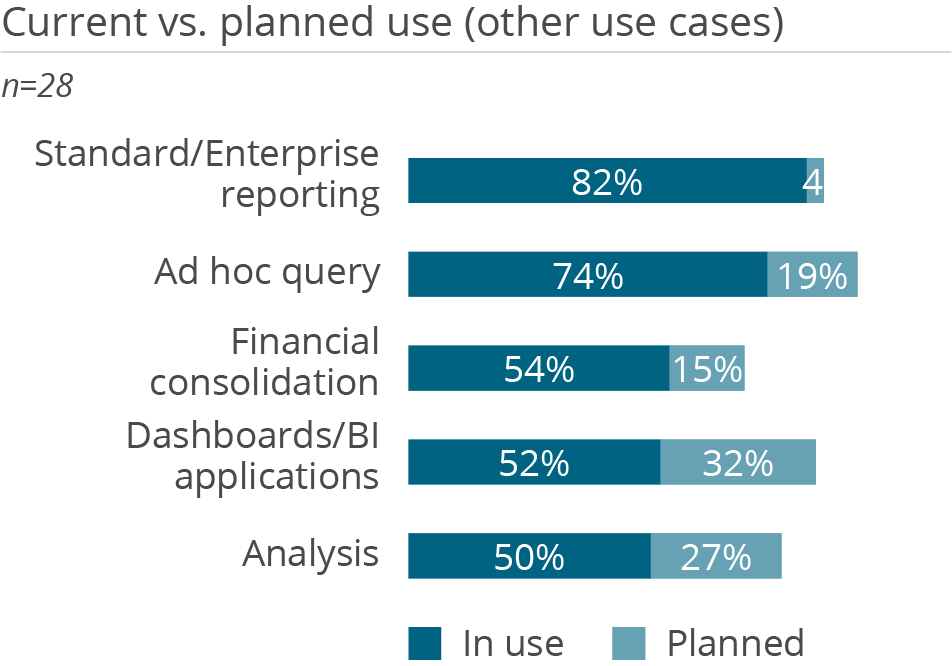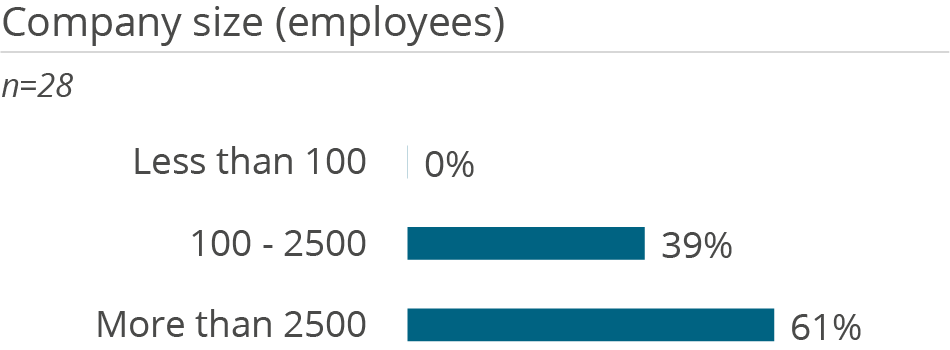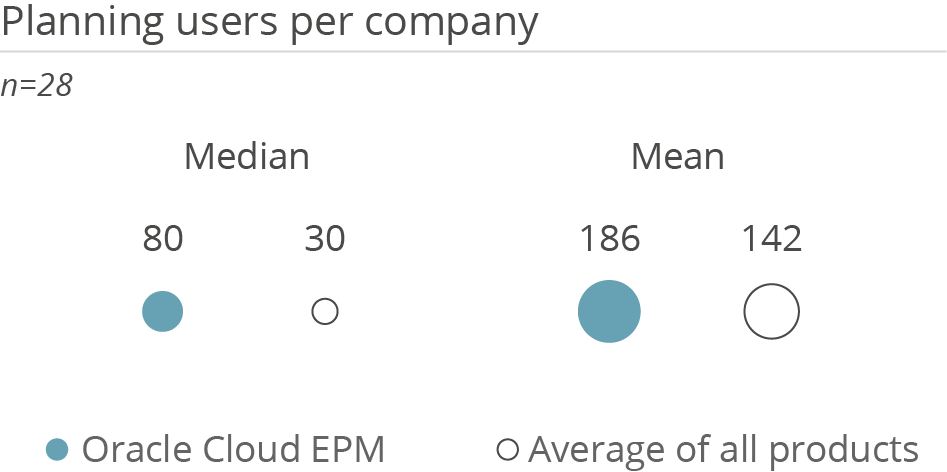Oracle Cloud EPM Planning
What is Oracle Cloud EPM Planning?
Cloud-based planning solution for company-wide planning, budgeting and forecasting processes as well as scenario simulations. Ready-made modules and frameworks for sales, HR, IT, marketing and supply chain operations.
About Oracle Cloud EPM Planning
Self-description of the vendor
Would you like to find out more about BARC reviews? Our FAQs answer the most important questions.
Oracle Cloud EPM Planning BARC Review & Rating
Provider and product description
Oracle is a global provider of enterprise cloud computing, offering software, platform, infrastructure and data as a service. The company employs more than 160,000 people worldwide and serves over 400,000 customers in 175 countries.
Oracle’s portfolio includes a comprehensive stack of cloud applications, platform services and engineered systems. Its cloud enterprise performance management (EPM) and analytics portfolios contain a comprehensive set of strategic offerings, which are packaged as Oracle Fusion Cloud EPM and Oracle Analytics Cloud. However, the company’s widely used on-premises solutions (e.g., Oracle Hyperion EPM) continue to be enhanced and fully supported. A variety of other cloud and on-premises offerings and applications complete Oracle’s broad product portfolio.
Oracle’s comprehensive EPM portfolio includes a full suite of products and applications covering all relevant EPM processes (e.g., planning, profitability and cost management, financial consolidation and close, account reconciliation, tax reporting, narrative reporting, freeform planning and reporting, sustainability/ESG reporting and planning, and enterprise data management). Oracle Cloud EPM is a cloud-native SaaS solution, delivered end-to-end from Oracle data centers around the world, owned and operated by Oracle itself. All Oracle Cloud EPM solutions are based on a consistent technical platform architecture, run on Oracle database technology and can be deployed in a modular fashion according to customer needs and priorities. For data integration from data sources, Oracle Cloud EPM provides native, wizard-based features, including predefined connectors and prebuilt adapters to Oracle and non-Oracle operational systems (e.g., ERP). For customers who prefer to manage EPM applications on premises, Oracle’s Hyperion EPM portfolio remains available (i.e., Oracle Hyperion Planning for planning and Oracle Hyperion Financial Management for financial consolidation and close). Oracle Cloud EPM has some ‘shared DNA’ with the on-premises Oracle Hyperion EPM portfolio, for example, leveraging the Microsoft Office add-in Oracle Smart View to work in Excel, Word and PowerPoint across both cloud and on-premises versions.
In terms of planning, Oracle Cloud EPM offers a broad range of capabilities for enterprise-wide integrated business planning processes. These capabilities include connected operational, financial and strategic planning, budgeting and forecasting as well as scenario simulations. Prebuilt modules and solutions include built-in best practices and expand the reach of Oracle’s planning solution beyond finance into HR, supply chain, IT and sales operations.
AI-driven finance is a major area of continued investment for Oracle, with a focus on intelligent automation, predictive insights and connected actions. To support users in their daily work, Oracle equips Cloud EPM continuously with intelligent EPM AI agents and assistants to drive speed and accuracy, detect issues and help find opportunities. In this context, Intelligent Performance Management (IPM) is an important concept that leverages Oracle Cloud EPM’s embedded statistical and ML features. IPM also supports the integration with third-party ML models and ML engines. Additionally, Oracle’s proprietary data science platforms and ML algorithms embedded in Oracle databases can be utilized.
Oracle’s flagship product for analytics, Oracle Analytics Cloud, is a platform for dashboards, formatted reports, ad hoc reports, analysis, data preparation and machine learning focused on business users. Data visualizations from Oracle Analytics Cloud can also be displayed on EPM dashboards. The on-premises version of Oracle Analytics Cloud, Oracle Analytics Server, brings all the capabilities of the cloud platform to organizations requiring on-premises deployment options. In addition, Oracle Fusion Analytics offers embedded analytics within the vendor’s portfolio of business applications. With its EPM suite, Oracle has adopted the strategy of embedding the analytics and reporting capabilities needed by the majority of customers and their users into the Cloud EPM platform as opposed to requiring customers to separately acquire Oracle Analytics Cloud.
Strengths and challenges of Oracle Cloud EPM Planning
BARC’s viewpoint on the product’s strengths and challenges.
Strengths
- Oracle’s comprehensive Cloud EPM portfolio includes a full suite of products and configurable applications covering all relevant EPM processes. All products are connected, based on a consistent technical platform architecture and can be deployed in a modular fashion.
- Oracle Cloud EPM Planning provides comprehensive capabilities for enterprise-wide planning, budgeting, forecasting and scenario simulations. It offers broad functionality for web-based, integrated business planning, including connected operational, financial and strategic planning in top-down and bottom-up planning scenarios. Prebuilt modules and solutions include built-in best practices and extend the reach of Oracle’s planning solution beyond finance to HR, supply chain, IT and sales operations, and sustainability planning (including reporting).
- The Planning Survey reveals a high level of customer satisfaction with Oracle Cloud EPM Planning, with the product receiving high ratings for its innovation and performance. Many customers say they would recommend the product to other organizations.
- Oracle Analytics Cloud is a comprehensive cloud and web-based platform offering formatted and ad hoc reports, analysis, visualization, data preparation and dashboards, all in one suite.
Challenges
- Oracle Cloud EPM is exclusively available on Oracle Cloud. Companies interested in deploying Oracle EPM software on other cloud services or on premises are required to utilize Oracle Hyperion EPM and to manage it themselves.
- The integration between product lines, such as Oracle Cloud EPM and Oracle Analytics Cloud, primarily occurs at data level, leveraging data models and structures. Oracle continuously enhances this integration. For instance, data visualizations from Oracle Analytics Cloud can be displayed on EPM dashboards. Oracle’s general approach embeds analytics capabilities directly into the EPM platform. In contrast to most other vendors, Oracle’s strategy treats EPM and analytics as related, but separate product lines.
- The pricing of Oracle’s EPM and analytics products is transparent but expensive compared to mid-market focused products. However, the cloud versions offer cost-effective editions for smaller organizations as well as alternatives for cost shifting to future periods and faster time to value. Pricing includes the Oracle cloud infrastructure (end-to-end) and AI capabilities, avoiding extra cost options. The suite-based Cloud EPM pricing offers cost advantages for customers implementing across multiple application areas, such as planning, financial close and account reconciliations.
- In contrast to previous years, the positivity of customer feedback for Oracle Cloud EPM has been in decline for the last two years. The feedback suggests that not all customers have achieved the business benefits they expected and not all projects have been succesful. Our survey data also indicates not everyone is satisfied with the implementation support provided by Oracle and its partners, nor with the product’s capabilities for data integration, workflow, simulation and financial consolidation.
Oracle Cloud EPM Planning User Reviews & Experiences
The information contained in this section is based on user feedback and actual experience with Oracle Cloud EPM Planning.
The information and figures are largely drawn from BARC’s The BI & Analytics Survey, The Planning Survey, The Financial Consolidation Survey and The Data Management Survey. You can find out more about these surveys by clicking on the relevant links.
Who uses Oracle Cloud EPM Planning in a planning context and how
Why users buy Oracle Cloud EPM Planning and what problems they have using it
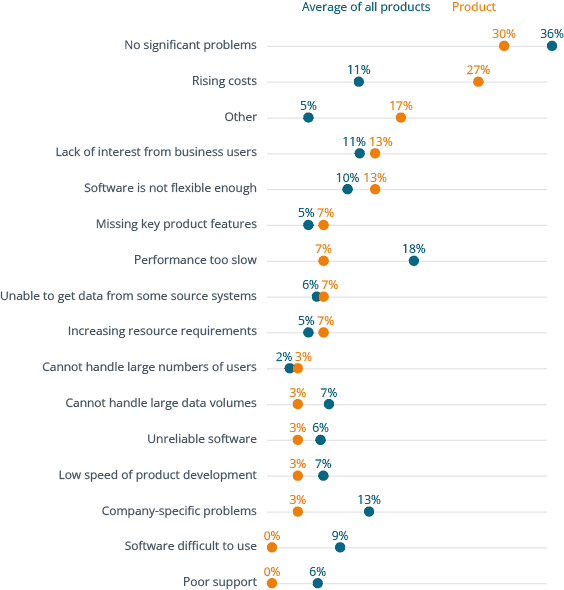
- Get independent information on software solutions, market developments and trends in data, analytics, business intelligence, data science and corporate performance management.
- Make data & analytics decisions based on numbers, data, facts and expert knowledge
- Access to all premium articles and all our research, including all software comparison studies, scores and surveys.
- Unlimited access to the BARC media library
- Consume unlimited content anywhere
Full user reviews and KPI results for Oracle Cloud EPM Planning
All key figures for Oracle Cloud EPM Planning at a glance.

- Get independent information on software solutions, market developments and trends in data, analytics, business intelligence, data science and corporate performance management.
- Make data & analytics decisions based on numbers, data, facts and expert knowledge
- Access to all premium articles and all our research, including all software comparison studies, scores and surveys.
- Unlimited access to the BARC media library
- Consume unlimited content anywhere
Individual user reviews for Oracle Cloud EPM Planning
Number of employees
Industry
Source
What do you like best?
Wide range of functionality for large enterprise.
What do you like least/what could be improved?
Cost and implementation time.
What key advice would you give to other companies looking to introduce/use the product?
Plan it well. Give it enough time.
How would you sum up your experience?
Industry leader.
Number of employees
Industry
Source
What do you like best?
Availability of REST API, Groovy/Jython support, and various options for data integration.
What do you like least/what could be improved?
Metadata management.
What key advice would you give to other companies looking to introduce/use the product?
If looking for lot of customization then this is the best tool, too expensive for out of the box features.
How would you sum up your experience?
A robust tool for customization, but expensive.
Number of employees
Industry
Source
What do you like best?
The ability to create a data-driven solution from the starting point (operational planning) to strategic planning. All our data are connected, which is very important for us. Additionally, the ability to create coherence in data through the built solution is an advantage for the whole organization, as there is no need to discuss the correctness of the data.
What do you like least/what could be improved?
The performance of the solution when certain data forms/reports are created. I know this depends on the amount of data read to create the data form/report, which is not something the user is typically aware of.
What key advice would you give to other companies looking to introduce/use the product?
When new users start an implementation project, they must ensure that the implementation team has the necessary resources, both with business and technical skills. There should be a master plan for the entire solution, starting with a minimally viable solution. Build upon that after the initial implementation.
How would you sum up your experience?
I really appreciate the Planning Solution. With this we can deliver a really complex solution in a simple manner to the users.
Number of employees
Industry
Source
What do you like best?
We're transitioning from an on-premise Hyperion environment, so the move is an easy one. Being in the cloud allows users across multiple organizations and different networks to collaborate and work in a single environment.
What do you like least/what could be improved?
Because our IT organization has concerns about passing data to the cloud, the interface timing from our ledger environments to EPM is longer and more complicated than we'd like, however we're aware that this is solely based on restrictions IT has placed on our implementation buildout and not a reflection of the capabilities of the EPM tool.
What key advice would you give to other companies looking to introduce/use the product?
We've found that having an admin with a finance background (vs. IT) is very helpful in ensuring the teams properly leverage the EPM tool and that it evolves as the business changes.
How would you sum up your experience?
It's a great tool that is fairly straightforward but offers a lot of flexibility. I'd say most people I've worked with in finance have used this tool in one of its forms, such as Essbase, Hyperion, etc., and that background knowledge is very helpful for user adoption.
Number of employees
Industry
Source
What do you like best?
Progressiveness in empowering end user to manage data and processes. Drawing on further integration between ERP and BI analytics for end-to-end user experience.
What do you like least/what could be improved?
Performance and lack of scalability when size of data increases.
What key advice would you give to other companies looking to introduce/use the product?
Do a thorough understanding of process, data and system need assessment so that you are able to chose which EPM offerings to best adopt.
How would you sum up your experience?
Introduction to AI/ ML is great but need more front-end user ability to shape data for the 'human' analysis.
Number of employees
Industry
Source
What do you like best?
The ability to build custom planning models and the ability to run and compare various versions of plan that have different underlying assumptions.
What do you like least/what could be improved?
The prebuilt planning solution did not work for our use cases, but it is what we implemented with. We wound up building a custom planning application from scratch and we are happy with where we have landed.
What key advice would you give to other companies looking to introduce/use the product?
It has been worthwhile bringing in an experienced Hyperion/EPM developer to build the solutions that we need within the tool.
How would you sum up your experience?
I feel that it EPM is what you can make of it. The system is a flexible platform that can support many different planning and reporting use cases.
Number of employees
Industry
Source
What do you like best?
Fast and straight forward to implement. Was a practical step for the users to move to the cloud version of planning from on premises.
What do you like least/what could be improved?
The Web UI can sometimes be clunky to work with, e.g., doing ad-hoc analysis in the Web, so we usually push users to SmartView.
What key advice would you give to other companies looking to introduce/use the product?
More time in the design phase (and prototyping) can save you a world of pain later.
How would you sum up your experience?
It's a very good product and in the hands of the right development partner can be a great asset to any organization.
Number of employees
Industry
Source
What do you like best?
Overall development of the software solution is strong, and the pipeline for enhancements is robust. Oracle is a known entity, and the tool will survive in any rationalization within the industry over time. The tool is also very flexible and scalable.
What do you like least/what could be improved?
Overall efficiency within the cloud for Oracle. They continue to improve, but there is still room for advancement in this area.
What key advice would you give to other companies looking to introduce/use the product?
The software will satisfy needs. In order to best leverage the software, work with a very strong consulting partner, and participate in user groups/events where you can share best practices.
How would you sum up your experience?
I am a big fan. I would recommend this solution to any company looking to advance their planning/budgeting capabilities.
Number of employees
Industry
Source
What do you like best?
The best of Oracle EPM are pre-build modules, Smart View, Flexibility.
What do you like least/what could be improved?
The integration aspect is still outdated in some aspects.
What key advice would you give to other companies looking to introduce/use the product?
Make sure if your metadata is diversified. Then controlling it from centrally may become quite a challenging. Ease of tool goes away in that case.
How would you sum up your experience?
Great tool.
Number of employees
Industry
Source
What do you like best?
SaaS - Stability is good, frequent updates. Functionality is good. You can use standard modules or build your own planning applications
What do you like least/what could be improved?
License cost.
What key advice would you give to other companies looking to introduce/use the product?
Base selection of modules on your specific needs.
How would you sum up your experience?
Functionality and flexibility is good, license cost is a bit high.
Number of employees
Industry
Source
What do you like best?
Innovation and enhancement requests are great.
What do you like least/what could be improved?
mMre AI functionality.
What key advice would you give to other companies looking to introduce/use the product?
Start now, run fast with the project.
How would you sum up your experience?
Excellent product.
Number of employees
Industry
Source
What do you like best?
I love how easy it is to admin the tool, I'm not IT and I can even manage to write some code. FCCS/PBCS are very user friendly! Task lists are a great hit with end users. The audit/job functions, as well as cell history are great traceability tools.
What do you like least/what could be improved?
I love data management, but it's slowly moving onto data exchange and it's not so easy to figure out how to do things there. Also, I'd love to have visibility on what is scheduled via Data Management (like we do in Jobs, for example).
What key advice would you give to other companies looking to introduce/use the product?
Before implementing, be sure of what structure you really need. Do not just replicate existing processes, evaluate improvements and make the most of a fabulous tool! Our partners (Nova) are amazing at understanding how we run our business and that helps a great deal. Having a partner that knows your company.
How would you sum up your experience?
I'm very happy with the tool. We have great control of our processes. Finance is the owner of the tool and this enables us to have freedom to keep adding functionalities to the tool. We are always looking for improvements, and love how flexible PBCS is to our business needs.
Number of employees
Industry
Source
What do you like best?
Ability to scale up.
What do you like least/what could be improved?
Good design and governance required to develop a well performing application.
What key advice would you give to other companies looking to introduce/use the product?
Importance of implementation partner and having setup strong planning processes.
How would you sum up your experience?
Market leading tool, great capability for large size companies. Especially when operating on a highly standardized environment.
Number of employees
Industry
Source
What do you like best?
Good continuity from the Hyperion planning and also the fact that EPM is part of the Oracle Cloud ERP eco-system.
What do you like least/what could be improved?
Not much analytics (reporting) tool build with it even in Oracle family like OAC or FAW.
What key advice would you give to other companies looking to introduce/use the product?
Limit the scope and number of drivers for the initial go-live.
How would you sum up your experience?
Overall powerful platform and well-integrated with consolidation platform.
Number of employees
Industry
Source
What do you like best?
It's potential to be a very good tool.
What do you like least/what could be improved?
Unfriendly towards the developers, seems as built by people who never had to support users.
What key advice would you give to other companies looking to introduce/use the product?
Get a good, mid-size, implementer specialized in Oracle EPM. Sort out your planning processes on a business side - software will not solve the problem of disparate processes between the departments.
How would you sum up your experience?
Nice tool, developing in it (including Essbase and on-prem Hyperion Planning) since 1999, but seems that the development is always too busy delivering features that are easy on Oracle's marketing department, and not on the IT ones who are supposed to use it one day. Too many things that can't be (easily) automated, or changed in bulk. And this in the end translates in bad image with business. Stick to one tool per area (one ETL, one reporting), add mass code/configuration change features, stop changing names of modules - it confuses everyone. IT will then be able to pay more attention to better designs, smoother processes, and thus increased user satisfaction.
Number of employees
Industry
Source
What do you like best?
Pouvoir retriever les chiffres sur Excel et à venir sur Google Sheet. Les possibilités du multidimensionnelle, gestion des dimensions, axes.
What do you like least/what could be improved?
L'interface n'est pas sexy que ce soit en mode web ou en smartviex. L'utilisation des menus n'est pas simple également. C'est vraiment ce qui ressort des sondages utilisateurs : outil pas UX et pas joli. J'ai connu Essbase il y a plus de vingt et j'ai été surprise en retravaillant dessus l'an dernier de constater qu'il avait peu évolué et que des bugs d'il y a 20 ans (exemple : enfant unique dans une dimension pas pris en compte en niveau 0 pour une extraction) étaient toujours d'actualité. En mode cloud, l'automatisation d'interfaces entrantes (hors ERPC) et sortantes de EPM (ex pour alimenter la GCP de google) est compliquée, voire impossible dans notre cas. On reste sur du bricolage et du manuel. Ce serait bien de plugger facilement les données des cubes Essbase vers un outil de reporting plus facile à utiliser et joli (ex : Power BI, Looker).
What key advice would you give to other companies looking to introduce/use the product?
–
How would you sum up your experience?
Bien dans le sens où il répond aux besoins actuels de simulations prévisionnelles forecast et budget de l'entreprise. Mais il y a de plus en plus d'outils sur le marché qui sont en plus d'être performants, plus simple à utiliser (apparence + UX) et je pense qu'Oracle devrait travailler cette partie. Côté admin, ce serait bien d'avoir plus de possibilités dans le cloud au niveau des interfaces entrantes et sortantes et de faciliter l'utilisation de l'outil (ex Data Management en mode web revu il y a quelques semaines n'est pas très pratique). L'automatisation d'import et d'export de données avec l'extérieur n'est pas simple. C'est un frein car ça engendre beaucoup de tâches manuelles (perte de temps, pas de valeur ajoutée).
